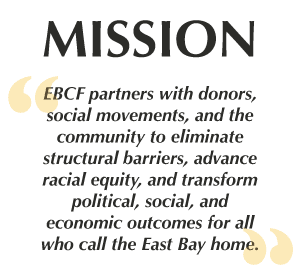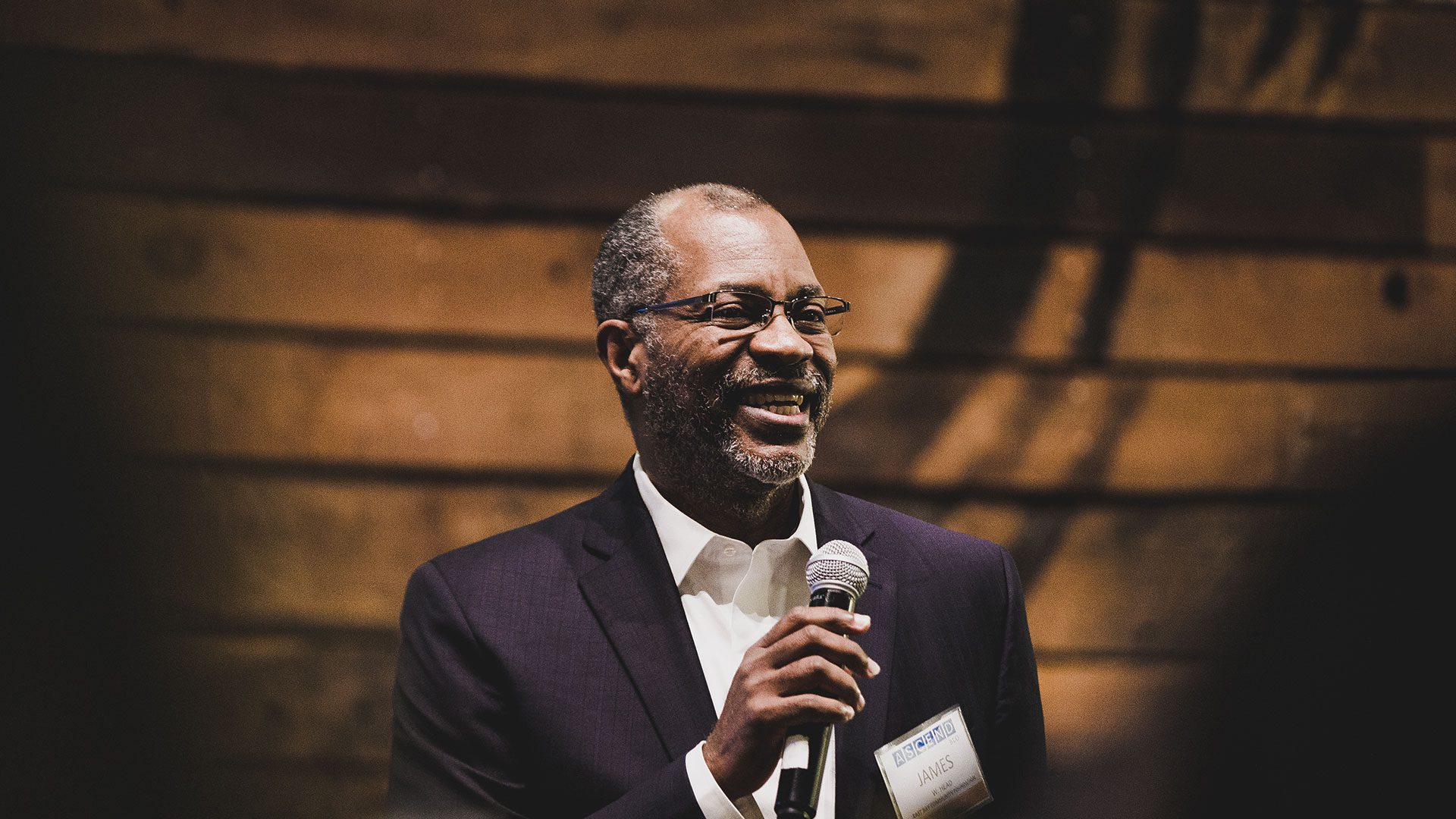EBCF is embarking on a bold, social justice vision to speed the social and economic transformation of East Bay Communities.
For over 90 years, the East Bay Community Foundation (EBCF) has proudly championed the diverse communities of the East Bay and the greater Bay Area. In 1928, the Foundation opened its doors as the Bay Area’s first community-based philanthropic organization and today, we have nearly a century of philanthropic service to the region. With a dedication to safeguarding the quality of life for all, EBCF has long played a key role in addressing the immediate challenges facing people in the East Bay to ensure that communities across Contra Costa and Alameda Counties can thrive.
When I joined as President and Chief Executive Officer in 2014, we started by examining the ways that our charitable endeavors had served the needs of our East Bay communities. Like most foundations, EBCF has always had a demonstrated commitment to helping low income and/or marginalized residents. Having worked in community development and philanthropy for the better part of 40 years, I know firsthand the resources that have been in communities to help alleviate hunger, reduce homelessness, or increase access to quality employment, healthcare, and education, among other philanthropic pursuits. Given these commitments, it is fair to say that our philanthropic efforts at large have resulted in a tremendous amount of good for the region.
Despite our collective philanthropic accomplishments and the great generosity of our partners—for many, the good that has come from our charitable contributions has not been good enough. Just three (3) short years ago, the 2016 Bay Area economy grew at a rate nearly 3 times faster than the national average. In spite of this economic vitality, low-income communities and communities of color continue to be impacted by social and economic inequity. This is expressly manifested in the staggering reality that at nearly every level of education attainment, East Bay communities of color have worse economic outcomes than their white counterparts; all the while constituting 58% (a majority) of the region’s population.
As the head of a philanthropic institution with a responsibility to the community, our donors, and our stakeholder partners, the question for me was whether we could continue our existing approach to philanthropy and expect to move the needle on equity in a meaningful way.
It didn’t take long to reach an unequivocal, “no.”
As a resident of the East Bay, it’s hard to ignore the reality that every day, communities are putting their future on the line in the fight for fairness and justice. With so much at stake, this is a pivotal time in our history to take action. It is through this courage and determination that the Foundation considered how we might rise to support communities in the advancement of equality and justice.
To meet today’s social and economic challenges, in partnership with our donors, EBCF is working toward a vision of an inclusive, fair, and just East Bay, where equitable outcomes are made possible by investing in leaders, organizations, and movements to create social, political, and economic opportunity. Dr. Martin Luther King Jr. once famously stated that “Philanthropy is commendable, but it must not cause the philanthropist to overlook the circumstances of economic injustice which make philanthropy necessary.” It is in this spirit that we are guided to build the social, economic, and political power of underserved communities throughout the East Bay.
Today, our country finds itself in a moment where greater public attention is increasingly being directed at issues that are central to the Foundation’s new mission. We think this represents an important opportunity to urge all citizens to live up to the promise of equity for all. For a community institution like EBCF, living up to this creed and our commitment to creating an inclusive, fair, and just East Bay requires that we behave in ways significantly different. It means being explicit about the policies and structures that contribute to inequity—it means seeking to better understand the lived experiences and effects of membership in oppressed groups/classes and finally, it means emphasizing grantmaking to organizations that work toward structural change to benefit those that are least well-off politically, economically, and socially.

It is our belief that funding social movements, led by communities that are directly impacted, will ultimately be the most effective driver of change to disrupt entrenched inequities, loosen access to public resources and create opportunities to benefit communities most in need. To some, this might sound revolutionary, but revolutions are not just about cannons or “bombs bursting in air.” The power of organizing, social movements, and the pursuit of an idea to transform opportunities have shown us what’s possible to affect systemic change. From hopes and dreams—to practical actions—to the creation of new realities, history has taught us that movements are seminal moments that have affirmed our collective humanity and moved us along the arc of justice. And support of organizing for social and economic justice is perhaps needed now, more than ever.
What This Means
As a community foundation, we are restructuring our financial, social, and human capital to support movements. This means more multi-year, general operating support for anchor nonprofits providing critical policy, advocacy, and essential services to our East Bay communities, with a focus on communities most in need. It means providing educational opportunities for our donors and partners to see and discuss the structural barriers that limit or prohibit many East Bay residents from taking advantage of opportunities to improve their lives. It means transforming our institutional, financial and human assets to be used for community benefits. And it means serving as a platform for community voice and organizing around those issues most important to achieving economic and social improvements. It is our hope that this approach will support community residents’ ability to strategize and consider how to strengthen innovative practices; all with a shared commitment to learning, deepening and challenging existing methods, and with an appetite for leadership. In support of this objective, we will institute a broader strategy to bring attention to the work and the underlying issues confronting East Bay communities.
I am excited to say that we are not alone on this journey. We have commitments from visionary donors and other community partners across the public, private, nonprofit, and community sectors to ensure that the East Bay continues to thrive. Investment with EBCF can be directed to support the critical work of donor-selected organizations or to fund transformative strategies through policy advocacy and community-led civic engagement. This combined approach enables the Foundation to address immediate community needs, while helping to advance legislation and policies that lead to a brighter future.
Finally, I would be remiss if I did not acknowledge that this kind of shift will not come without its risks as every new initiative brings some level of uncertainty in outcome. Along the way, we know that we will confront concerns that may challenge long-standing relationships with some donors, grantees, staff, or other partners. To date, we are discovering that our approach has come with ample opportunities for organizational and individual learning and growth. We are guided by the wisdom that piloting new work in phases allows for the time and space to course correct and the ability to iterate on what we will learn along the way. As neighbors to our technology friends in the South Bay, we take solace in the lessons learned from Silicon Valley in that the learnings one gets from failure are instructive. And the earlier we learn, the faster we succeed.
This path to building a justice-focused identity has richly increased our knowledge and capacity as an institution. As we move into our organizational realignment, we are proud of the visible examples of how the Foundation has leaned into our new vision: the launch of ASCEND:BLO to build the capacity of vital, Black-led, community organizations—the establishment of the Early Childhood Progress Fund to provide resources to policy-focused campaign initiatives—and our recent forays into mission-aligned investments and donor leadership. As we continue to define what our future looks like, we promise to celebrate our successes, learn from our failures, and make adjustments to ensure that we are continually moving towards a just East Bay.
Understanding that our aspirations for the region exceed the Foundation’s current financial means, we will continue engaging with peer institutions and generous partners in community transformation to bring new and expanded resources to this work, either through aligned funding or formal collaborations.
On behalf of the Board of Trustees and the staff of the East Bay Community Foundation, we are incredibly excited for this next iteration of community philanthropy and the transformative change that it portends. And we are confident that the indomitable spirit of the East Bay and its residents will prevail with a stronger region that works for all. We invite you to follow us on this journey and stay up to date by subscribing to “Inside EBCF” and follow us on social media (@eastbaycf) to accompany EBCF on this ambitious and critical endeavor.
Sincerely,
James W. Head
President and Chief Executive Officer
East Bay Community Foundation
